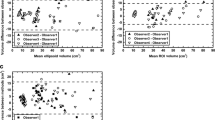Abstract
Background: Pontine tumors carry the worst prognosis of all brain tumors. In most cases, the diagnosis is based solely on MR imaging, without biopsy. Objective: To describe the MR findings of pontine tumors at diagnosis and during follow-up and correlate those with prognosis and to assess the value of MR imaging in patient management compared to clinical evaluation. Materials and methods: Ninety-one MR scans of 15 children with diffuse pontine tumors were reviewed at diagnosis and during follow-up. The parameters analyzed were as follows: tumor extent, area, and volume; encasement of the basilar artery; presence of exophytic component; necrosis; cysts; hydrocephalus; and intensity and enhancement. Findings were correlated to length of progression-free and overall survival. Trends of amelioration or worsening on imaging were compared with the clinical findings. Results: Median length of progression-free survival was 10 months, and median survival was 20 months. Only hydrocephalus at presentation was associated with shorter progression-free survival (P=0.02). On the last examination of each patient, the craniocaudal diameter was significantly greater than at diagnosis (P=0.03). The concordance between the imaging and the clinical findings was good.Conclusion: MR is the mainstay for the diagnosis and management of pontine tumors. Cranial growth seems to be an ominous sign. However, the prognostic value of MR is limited. MR findings correlate well with the clinical examination.



Similar content being viewed by others
References
Jallo GI, Biser-Rohrbaugh A, Freed D (2004) Brainstem gliomas. Child’s Nerv Syst 20:143–153
Barkovich AJ, Krischer J, Kun LE, et al (1990) Brain stem gliomas: a classification system based on magnetic resonance imaging. Pediatr Neurosurg 16:73–83
Epstein FJ, Farmer JP (1993) Brain-stem glioma growth patterns. J Neurosurg 78:408–412
Kaplan AM, Albright AL, Zimmerman RA, et al (1996) Brainstem gliomas in children. Pediatr Neurosurg 24:185–192
Behnke J, Chirsten HJ, Bruck W, et al (1997) Intra-axial endophytic tumors in the pons and/or medulla oblongata. I. Symptoms, neuroradiological findings and histopathology in 30 children. Child’s Nerv Syst 13:122–134
Fischbein NJ, Prados MD, Wara W, et al (1996) Radiological classification of brain stem tumors: correlation of magnetic resonance imaging appearance with clinical outcome. Pediatr Neurosurg 24:9–23
Freeman CR, Farmer JP (1998) Pediatric brain stem gliomas: a review. Int J Radiat Oncol Biol Phys 40:265–271
Bouffet E, Raquin M, Doz F, et al (2000) Radiotherapy followed by high dose busalfan and thiotepa. A prospective assessment of high dose chemotherapy in children with diffuse pontine gliomas. Cancer 88:685–692
Benesch M, Lackner H, Moser A, et al (2001) Outcome and long-term side effects after synchronous radiochemotherapy for childhood brain stem gliomas. Pediatr Neurosurg 35:17–180
Farmer JP, Montes JL, Freeman CR, et al (2001) Brainstem gliomas. A 10-year institutional review. Pediatr Neurosurg 34:206–214
Walker DA, Punt JAG, Sokal M (1999) Clinical management of brain stem glioma. Arch Dis Child 80:558–564
Guillamo JS, Doz F, Delattre JY (2001) Brain stem gliomas. Curr Opin Neurol 14:711–715
Fisher PG, Breiter SN, Carson BS, et al (2000) A clinicopathologic reappraisal of brain stem tumor classification. Identification of pilocytic astrocytoma and fibrillary astrocytoma as distinct entities. Cancer 89:1569–1576
Dixon WJ (1992) BMDP statistical software. University of California Press, Los Angeles
Cartmill M, Punt J (1999) Diffuse brain stem glioma. A review of stereotactic biopsies. Child’s Nerv Syst 15:235–237
Behnke J, Christen HJ, Mursch K, et al (1997) Intra-axial endophytic tumors in the pons and/or medulla oblongata. II. Intraoperative findings, postoperative results and 2-year follow-up in 25 children. Child’s Nerv Syst 13:135–146
Albright AL, Packer RJ, Zimmerman R, et al (1993) Magnetic resonance scans should replace biopsies for the diagnosis of diffuse brain stem gliomas: a report from the Children’s Cancer Group. Neurosurgery 33:1026–1103
Zagzag D, Miller DC, Knopp E, et al (2000) Primitive neuroectodermal tumors of the brain stem: investigation of seven cases. Pediatrics 106:1045–1053
Khatib ZA, Heideman RL, Kovnar EH, et al (1994) Predominance of pilocytic histology in dorsally exophytic brain stem tumors. Pediatr Neurosurg 20:2–10
Hoffman HJ (1996) Dorsally exophytic brain stem tumors and midbrain tumors. Pediatr Neurosurg 24:256–262
Burger PC (1996) Pathology of brain stem astrocytomas. Pediatr Neurosurg 24:35–40
Packer RJ, Zimmerman RA, Kaplan A, et al (1993) Early cystic/necrotic changes after hyperfractionated radiation therapy in children with brain stem gliomas. Cancer 71:2666–2674
Nelson MD Jr, Soni D, Baram TZ (1994) Necrosis in pontine gliomas: radiation induced or natural history. Radiology 191:279–282
Galanis E, Buckner JC, Novotny P, et al (2000) Efficacy of neuroradiological imaging, neurological examination, and symptom status in follow-up assessment of patients with high-grade gliomas. J Neurosurg 93:201–207
Wiegell MR, Laisson HBW, van Weeden J (2000) Fiber crossing in human brain depicted with diffusion tensor MR imaging. Radiology 217:897–903
Kashimura H, Inoue T, Ogasawara K, et al (2003) Preoperative evaluation of neural tracts by use of three-dimensional anisotropy contrast imaging in a patient with brain stem cavernous angioma: technical case report. Neurosurgery 52:1226–1229
Curless RG, Bowen BC, Pattany PM, et al (2002) Magnetic resonance spectroscopy in childhood brain stem tumors. Pediatr Neurol 26:374–378
Acknowledgments
The authors thank Shlomo Michael and Zvi Cohen for their technical assistance and Pnina Lilos for statistical assistance.
Author information
Authors and Affiliations
Corresponding author
Rights and permissions
About this article
Cite this article
Kornreich, L., Schwarz, M., Karmazyn, B. et al. Role of MRI in the management of children with diffuse pontine tumors: a study of 15 patients and review of the literature. Pediatr Radiol 35, 872–879 (2005). https://doi.org/10.1007/s00247-005-1502-y
Received:
Revised:
Accepted:
Published:
Issue Date:
DOI: https://doi.org/10.1007/s00247-005-1502-y




